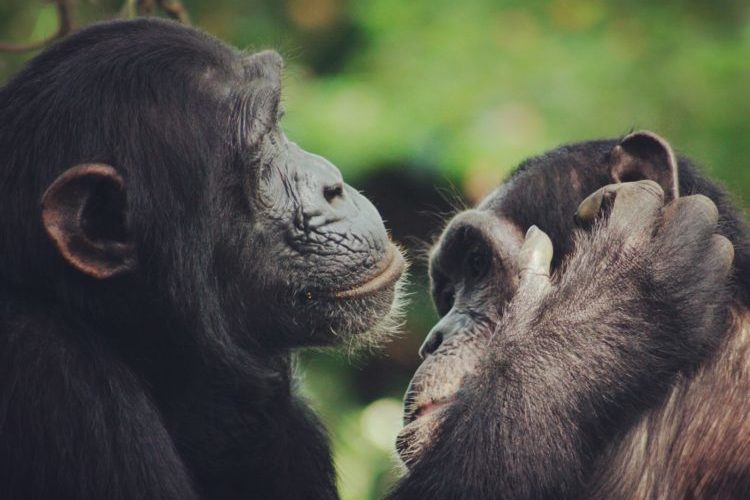
One of the most promising theories for the evolution of human speech has finally received support from chimpanzee communication, in a study conducted by a group of researchers led by the Universities of Warwick and St Andrews.
The evolution of speech is one of the longest-standing puzzles of evolution. However, inklings of a possible solution started emerging some years ago when monkey signals involving a quick succession of mouth open-close cycles were shown to exhibit the same pace of human spoken language.
The paper 'Chimpanzee lip-smacks confirm primate continuity for speech-rhythm evolution', published today (Wednesday 27 May) in the journal Biology Letters, reveals that the rhythm of chimpanzee lip-smacks also exhibit a speech-like signature, a critical step towards a possible solution to the puzzle of speech evolution.
Just like every language in the world, monkey lip-smacks have previously shown a rhythm of about five cycles/second (i.e., 5Hz). This exact rhythm had been identified in other primate species, including gibbon song and orangutan consonant-like and vowel-like calls. However, there was no evidence from African apes, such as gorillas, bonobos and chimpanzees - who are related more closely to humans - meaning the plausibility of this theory remained on hold.
The team of researchers, from the University of St Andrews, in collaboration with the Universities of York and Warwick, used data from four chimpanzee populations to confirm that they too produce mouth signals at a speech-like rhythm. The findings show there has most likely been a continuous path in the evolution of primate mouth signals with a 5Hz rhythm, proving that evolution recycled primate mouth signals into the vocal system that one day was to become speech.
African great apes, the closest species to humans, had never been studied for the rhythm of their communication signals. Researchers investigated the rhythm of chimpanzee lip-smacks, produced by individuals while they groom another, and found that chimpanzees produce lip-smacks at an average speech-like rhythm of 4.15Hz.
Researchers used data across two captive and two wild populations, using video recordings collected at Edinburgh Zoo and Leipzig Zoo, and recordings of wild communities including the Kanyawara and the Waibira community, both in Uganda.
Dr Adriano Lameira, from the Department of Psychology at the University of Warwick, comments:"Our results prove that spoken language was pulled together within our ancestral lineage using 'ingredients' that were already available and in use by other primates and hominids. This dispels much of the scientific enigma that language evolution has represented so far.
"We can also be reassured that our ignorance has been partly a consequence of our huge underestimation of the vocal and cognitive capacities of our great ape cousins.
"We found pronounced differences in rhythm between chimpanzee populations, suggesting that these are not the automatic and stereotypical signals so often attributed to our ape cousins. Instead, just like in humans, we should start seriously considering that individual differences, social conventions and environmental factors may play a role in how chimpanzees engage 'in conversation' with one another.
"If we continue searching, new clues will certainly unveil themselves. Now it's a matter of mastering the political and societal power to preserve these precious populations in the wild and continue enabling scientists to look further."
Similarly to chimpanzees, fast-paced mouth signals with a speech-like rhythm have now been described in orangutans and several monkey species, confirming altogether that speech has ancient roots within primate communication.
Dr Cat Hobaiter, a field primatologist and lecturer in the School of Psychology and Neuroscience at the University of St Andrews, said: "We have so many spoken languages, but they all have a common rhythm. Fascinatingly, this same rhythm seems to run through our primate family tree.
"One fascinating aspect is that in monkey species these rhythms are very consistent, while in human languages there is a little more variation. We see that same sort of variation between individuals and between groups in the chimpanzees as well - suggesting that they share some of that human-like flexibility."
The paper 'Chimpanzee lip-smacks confirm primate continuity for speech-rhythm evolution' is published in the journal Biology Letters and is available online.
Please ensure that the paper's DOI (doi.org/10.1098/rsbl.2020.0232) is included in all online stories and social media posts and that Biology Letters is credited as the source.
Photo caption: Two chimpanzees grooming each other.
Credit: Dr Catherine Hobaiter
Video available to view via YouTube.
Credit: Katie Slocombe






